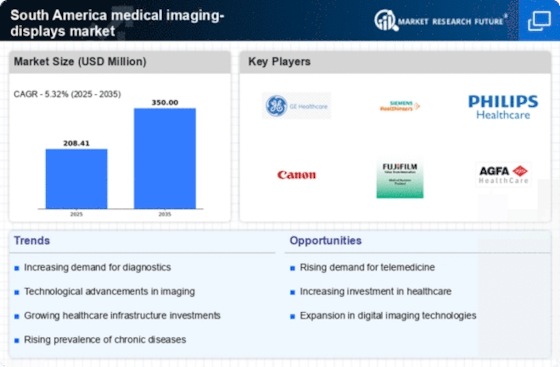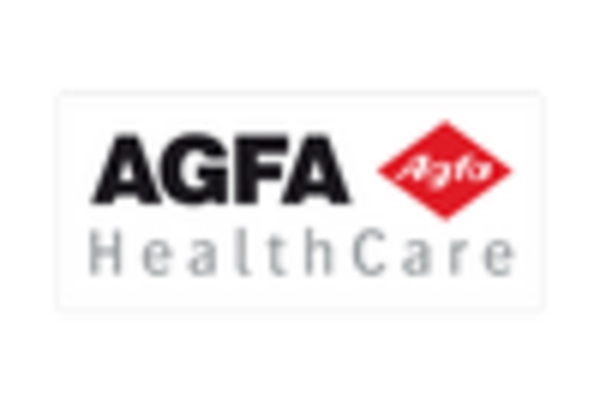Growing Aging Population
The demographic shift towards an aging population in South America significantly influences the medical imaging-displays market. As the population ages, there is an increased prevalence of chronic diseases that require advanced diagnostic imaging. For example, the elderly population in South America is expected to reach 15% by 2030, leading to a higher demand for medical imaging services. This demographic trend necessitates the use of high-resolution imaging displays to ensure accurate diagnosis and treatment planning. Consequently, healthcare providers are likely to invest in advanced imaging technologies, thereby driving the growth of the medical imaging-displays market. The correlation between an aging population and the demand for medical imaging solutions indicates a sustained market expansion in the coming years.
Rising Healthcare Expenditure
The increasing healthcare expenditure in South America is a pivotal driver for the medical imaging-displays market. Governments and private sectors are allocating more funds towards healthcare infrastructure, which includes advanced imaging technologies. For instance, Brazil's healthcare spending is projected to reach approximately $200 billion by 2025, indicating a robust investment in medical technologies. This financial commitment is likely to enhance the adoption of high-quality imaging displays, as healthcare facilities seek to improve diagnostic accuracy and patient outcomes. Furthermore, as healthcare budgets expand, hospitals and clinics are more inclined to upgrade their imaging systems, thereby propelling the demand for sophisticated medical imaging-displays. This trend suggests a positive trajectory for the market, as enhanced financial resources facilitate the procurement of state-of-the-art imaging solutions.
Expansion of Healthcare Facilities
The expansion of healthcare facilities across South America is a significant driver for the medical imaging-displays market. New hospitals and diagnostic centers are being established to meet the growing healthcare demands of the population. For instance, Brazil and Colombia are witnessing a surge in the construction of healthcare facilities, which is expected to increase the availability of medical imaging services. This expansion necessitates the procurement of advanced imaging technologies, including high-resolution displays, to ensure optimal diagnostic capabilities. As more healthcare facilities come online, the demand for medical imaging-displays is likely to rise, creating a robust market environment. The ongoing development of healthcare infrastructure indicates a promising outlook for the medical imaging-displays market in the region.
Technological Integration in Healthcare
The integration of advanced technologies in healthcare systems is a crucial driver for the medical imaging-displays market. Innovations such as artificial intelligence (AI) and machine learning are increasingly being incorporated into imaging solutions, enhancing diagnostic capabilities. In South America, hospitals are beginning to adopt these technologies to improve workflow efficiency and diagnostic accuracy. For instance, AI algorithms can analyze imaging data more rapidly than traditional methods, allowing for quicker decision-making in clinical settings. This technological evolution not only improves patient care but also stimulates the demand for high-quality imaging displays that can support these advanced functionalities. As healthcare providers continue to embrace technological integration, the medical imaging-displays market is poised for significant growth.
Increased Focus on Preventive Healthcare
The rising emphasis on preventive healthcare in South America is driving the medical imaging-displays market. As healthcare systems shift towards preventive measures, the demand for diagnostic imaging increases, enabling early detection of diseases. Countries like Argentina and Chile are implementing national health programs that prioritize preventive care, which includes regular imaging screenings. This focus on prevention is likely to lead to a higher utilization of medical imaging services, thereby boosting the need for advanced imaging displays. The market is expected to benefit from this trend, as healthcare facilities invest in high-quality imaging technologies to support preventive healthcare initiatives. The alignment of healthcare policies with preventive strategies suggests a favorable environment for the medical imaging-displays market.

















Leave a Comment